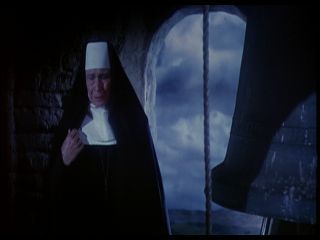The MacGuffin: News and Comment (05/Jul/2008)
(c) Ken Mogg (2008)
July 05
'How ghostly!' wrote Eric Bentley about the relation of play and audience in the live theatre ('the theatrical occasion', as he called it - see above, June 21 and June 28). A well-known book on the nature of film is called 'The Celluloid Ghost'. Alfred Hitchcock was fascinated by ghost stories and plays, including his cherished project to film J.M. Barrie's 'Mary Rose'. I have suggested (see above, June 28) that there are correspondences in Hitchcock's films with the plays of Henrik Ibsen, one of which was called 'Ghosts' (the title referring in part to a 'bourgeois' tendency to put 'duty' above 'joy', to settle for hypocrisy and self-deception over honesty). Several of Hitchcock's films from Rebecca onwards have 'ghostly' elements, but especially there's his masterpiece Vertigo. I suggested last time (June 28) that Vertigo is both erotic and about something more, the very life/death force itself (Will). Coit Tower in Vertigo symbolises Scottie's eroticism (focussed on the girl Judy); the tower at San Juan Bautista, which effectively subsumes Coit Tower, symbolises Scottie's quest for the transcendental and the numinous (focussed on the 'ghostly' woman he knows as Madeleine). Today I want to suggest that Vertigo is both a ghost story and a literal detective story whose ultimate subject is the nature of the film audience - with especial reference to the nature of viewing film ('the film occasion' we might call it). It thus deals with illusion and reality, with elements drawn from both the traditional ghost story (but especially the English ghost story - I'll explain that in a moment) and from the nature of society (and epistemology and ontology), i.e., Ibsenesque elements. It is a complex, profound masterpiece indeed. Okay. In the mid-1930s Hitchcock spoke of how he made films for audiences who 'have become sluggish and jellified'. A decade earlier, Agatha Christie had dedicated her adventure-thriller 'The Secret Adversary' (1922) 'to all those who lead monotonous lives, in the hope that they may experience at second-hand the delights and dangers of adventure'. (Hmm. Thank you for condescending, ma'am!) Here's my point. In a splendid chapter on "Ghosts" in his book 'Albion: The Origins of the English Imagination' (2002), Peter Ackroyd draws attention to how, in the 1920s and 1930s, a recrudescence of ghost stories in England had coincided with the so-called Golden Age of detective fiction. He draws a particular parallel between the two forms. Ghost stories, he notes, such as those of the British master, M.R. James (1862-1936), are often reticent about sexuality. Likewise, '[t]he great English fictional detectives - Sherlock Holmes, Miss Marple, Father Brown - are curiously sexless figures, while sex itself is the instigator of crime and iniquity. It is a very native displacement of passion.' Well, isn't this largely true of Vertigo as well? Behind the film is Gavin Elster's affair with Judy and the murder of his wife (with parallels to the story of his wife's grandmother Carlotta Valdes), but the film itself is in large measure about Scottie's attempt to solve the mystery of 'Madeleine' who has ghostly, uncanny qualities. (Hitchcock even dressed the character in grey, the better to suggest that she had just emerged, like a ghost, from the San Francisco fog.) On the other hand, of course, Scottie starts to fall in love with 'Madeleine' (and later Madeleine-in-Judy). The film might thus be supposed to give the audience everything we could want: sublimation and/or scepticism, and spectacle, but also sexual fulfilment (represented by the famous 360° shot in Judy's hotel room), while moving the narrative steadily, like an Ibsen play, to an ambiguous, multivalent conclusion (see above, June 28). This conclusion, in which Madeleine-in-Judy falls to her death, and a nun (or 'mother-superior figure') stands in for a ghost, may be read in at least two ways. Today I want to concentrate on the 'ghostly' aspects, and in a minute I'll draw again on Ackroyd. First, the nun is made to rise up, silently, like an apparition or ghost, frightening poor Judy to her death. (Judy, an accomplice in murder, has had good reason to feel scared - of the ghost of the real Madeleine perhaps.) The nun's black robes are thus apt, even as they imply - by opposition - the conventional white spectral appearance of a revenant. Next, here's something that Ackroyd points out: that M.R. James, not himself a Catholic, had studied Church history, and in particular 'the martyrdom of the saints', so that he was not untouched by intimations of the Catholic past. The vengeful ghosts in his stories might, or might not, show Catholics in a good light. One James character, who has survived a ghostly encounter, remarks wryly that events have only 'served to confirm his opinion of the Church of Rome'! But Ackroyd also writes this: '[Father] Ronald Knox established a Detection Club in 1929 for the sole purpose of excluding "Divine Revelation, Feminine Intuition, Mumbo-Jumbo, Jiggery-Pokery", an antipathy which represents an index of the English sensibility itself.' I've space only to suggest that the nun at the end of Vertigo may be either a 'bad' ghost (a representative of the old unenlightened ways) or a 'good' ghost (who takes compassion on our human failings, our misguidedness, our failure from ignorance or circumstance to grasp 'joy'). More next time.
This material is copyright of Ken Mogg and the Hitchcock Scholars/'MacGuffin' website (home page) and is archived with the permission of the copyright holder. |

